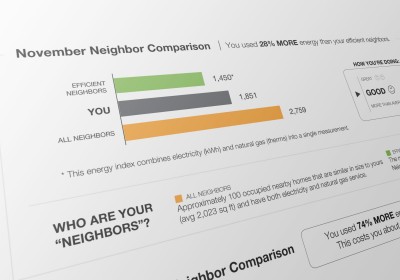 Smarter electric bills make smarter consumers.Over the years, I’ve written quite a bit about social psychology, behavioral research, and how they can be used to encourage energy efficiency and conservation. I’ve also written quite a bit about Opower, a company that uses behavioral insights to help utilities communicate more effectively with their customers. (See links at the bottom of this post.) So it’s nice to see EDF releasing a study of Opower’s work: “Behavior and Energy Savings: Evidence from a Series of Experimental Interventions” [PDF]. The results are promising.
Smarter electric bills make smarter consumers.Over the years, I’ve written quite a bit about social psychology, behavioral research, and how they can be used to encourage energy efficiency and conservation. I’ve also written quite a bit about Opower, a company that uses behavioral insights to help utilities communicate more effectively with their customers. (See links at the bottom of this post.) So it’s nice to see EDF releasing a study of Opower’s work: “Behavior and Energy Savings: Evidence from a Series of Experimental Interventions” [PDF]. The results are promising.
The study tracks the use of “Home Energy Reports,” which are sent to homeowners with their electric bills. The reports not only track power use, but they track how it compares to the neighbors’ power use. That brings a social element into what has typically been a solitary affair. It triggers the herd instinct, status competition, identity signaling, and other psychosocial dynamics.
The study tracks the reports in “11 different utility service areas encompassing more than 750,000 households across the United States.” This, by the way, is Opower’s greatest contribution: not so much the quality of the initial interventions, though those are cool too, but the sheer quantity of data they’re producing. They’re going to be running longitudinal experiments on millions of people — that’s a gold mine for researchers. (Another early study along these lines is “Social Norms and Energy Conservation” [PDF] by Hunt Allcott.)
Here’s the EDF study’s top-line finding:
Reports sent to a random subset of customers are shown to reduce energy demand by 1.8% on average, with the effectiveness of individual programs ranging from 0.9% to 2.9%. Furthermore, using a single readily available statistic — a household’s average monthly energy usage before the intervention — can help identify the households most likely to show large reductions and increase average effectiveness to 6.5% overall. To get a sense of the magnitude of these effects, a simple extrapolation of the savings rate suggests that reducing residential electricity usage across the United States by 1.8% would save over 26,000 GWh of electricity, reduce greenhouse gas emissions by roughly 8.9 million metric tons of carbon dioxide per year — equal to the emissions from three 500-MW coal-fired power plants — and save households just over $3 billion per year on their electric bills.
Maybe 1.8 percent doesn’t seem like much, but 26,000 GWh sure does. And the important thing about this kind of intervention is that it’s basically free. Utilities send monthly bills to customers anyway. All that’s required is that they include different information on the bills. Obviously they have to pay Opower, but (perhaps uncomfortably for Opower) there’s nothing to stop information about these techniques from getting out to the public and being used by any utility. The market, I suppose, will be in crafting the cleverest behavioral interventions.
For just that reason, 1.8 percent is only the beginning. This is a discipline in its infancy and as more minds (and experiments) are brought to bear, those numbers are likely to go up.
More posts on behavioral stuff:
- Never mind what people believe—how can we change what they do? A chat with Robert Cialdini
- Making buildings more efficient: It helps to understand human behavior
- Using behavioral science to make smarter energy policy
- Brian Baird: ‘This is not government mind control’
- On habits and how to change them
- Smart readers weigh in on behavior change
- What’s the real potential for behavior-change programs?
- Behavior change: we’re already doing it [VIDEO]



